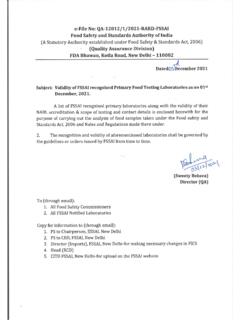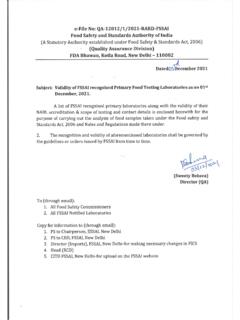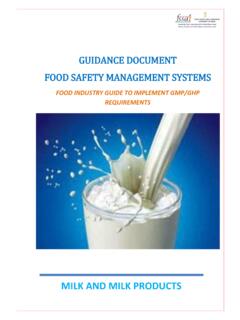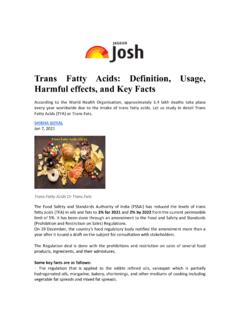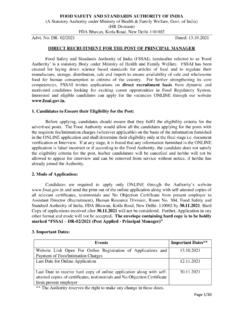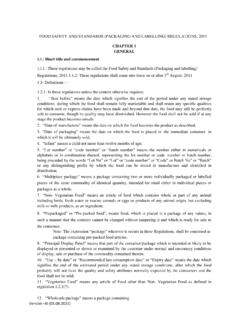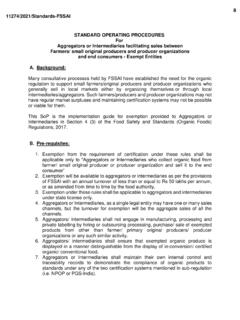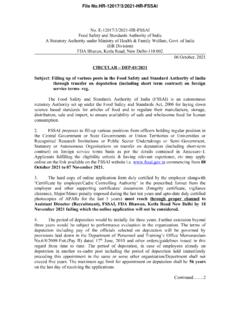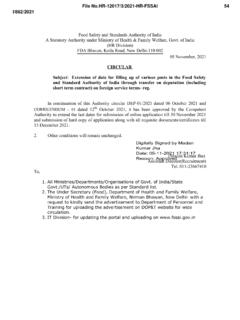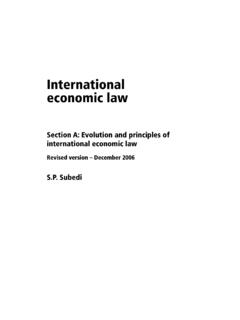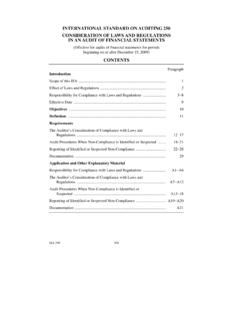Transcription of A. Food Laws and Standards of India and International Food ...
1 Indicative Syllabus for CBT/CBT (Stage I)/Written Examination (Advertisement No DR-04/2021 dated 30 Sep 2021) 1 Name of Post Food Analyst (Pay Level-10) Scheme of examination: Exam Format Written Test will be of 180-minute duration with 16 subjective type questions. A. Food laws and Standards of India and International Food laws : (4 Questions x Marks) I. Food Safety and Standards Act of India , 2006, Provision, definitions and different sections of the Act and implementation. II. FSS Rules and Regulations (2011) as amended from time to time a) Licensing and registration; Central license, State license, Registration, Responsibilities of the FBO, Role of Designated officer, Food Safety Officer and Food Analyst.
2 B) Standards of Quality and Safety of Food & Food Products laid down in the FSS Regulations, 2011. The different food categories in the Act. The relevance of the Standards (Vertical and Horizontal) quality and safety parameters to particular foods including current food safety issues. c) Regulations of food additive: What is an additive, various groups of additives and their technological functions, INS number: food colors, antioxidants, sweeteners, preservatives, processing aids. Food processing aids. The Indian Food Code and using the hierarchy to understand the category wise approval of food additives.
3 D) Packaging and labelling rules and regulations: List of ingredients, nutritional information, special label declarations, claims-Health, nutrition, nutrient led claims, use of words and phrases on label. e) Regulations for Contaminants, Toxins and Residues and restriction of sales. f) Food Safety and Standards (Food or Health Supplements, Nutraceuticals, Foods for Special Dietary Uses, Foods for Special Medical Purpose, Functional Foods and Novel Food) Regulations, 2016 Food Safety and Standards (Food Recall Procedure) Regulations, 2017 Food Safety and Standards (Import) Regulations, 2017.
4 G) Food Safety and Standards (Organic Food) Regulation, 2017. Food Safety and Standards (Fortification of Foods) Regulations, 2018 Food Safety and Standards (Alcoholic Beverages) Regulations, 2018. h) Laboratory sampling and analysis: The role of Referral labs, FSSA notified laboratories and State Food Laboratories and function. Receiving legal samples, sample custody and sample custodian. Storage of sample. Required documentation and registration, storage of the sample Analyses as per FSS Rules and Regulations (2011). III.
5 Other National laws and Standards : a) Agricultural Produce Act, 1937 (Grading and Marketing) b) Export (Quality Control & Inspection), Act, 1963 and Rules c) Bureau of Indian Standards relevant to Food Safety (Water, Infant Formula etc.) d) Legal Metrology Act IV. International Food Control Systems/ laws , Regulations and Standards /Guidelines with regard to Food Safety: a) CODEX Alimentarious Commission: History, Members, Standard setting and Advisory mechanisms: JECFA, JEMRA, JMPR b) WTO agreements: SPS/TBT c) Role of OIE, IPPC. Indicative Syllabus for CBT/CBT (Stage I)/Written Examination (Advertisement No DR-04/2021 dated 30 Sep 2021) 2 B.
6 Planning Organization and setting up of Food Analysis Laboratory including NABL / ISO / IEC-17025: 2017 and laboratory safety. (4 Questions x Marks) I. Understand the requirements for setting up a laboratory for the legal defensibility of analytical data. The ideal structure design, environment, layout for chemical and microbiological testing, Air handling etc. II. What is accreditation, Different accreditation bodies (NABL, APLAC, ILAC). Requirements for ISO/IEC 17025:2017, documentation, pre-requisites for accreditation, management requirements, technical requirements, measurement of traceability.
7 III. Laboratory safety: Personnel and laboratory hygiene, emergency planning, General hazards in a food laboratory, safety equipment, storage of chemicals, acids, flammables etc., handling compressed gases, centrifuge, chemical and biological spills and waste disposal. C. Physical, Chemical and Instrumental analysis (4 Questions x 10 Marks) I. Sampling and sample preparation: Definition, types of sample, sampling plan, subsampling, designing sampling plan, concept of sample size and representative. Sample preparations particle size, homogeneity, dissolution technology and decomposition, storage of samples.
8 Solid Phase Extraction - Introduction, sorbents, matrix solid phase dispersion and applications. II. Statistics and statistical terms: Systematic and random errors. Mean distribution. Confidence interval. Confidence limits and confidence level, Outliers. Definition and calculation of: Average, Mean, Standard deviation, Relative standard deviation, Coefficient of variation, Confidence limits of a measurement, Statistical Tests, Linear correlation and regression curve fitting, fitting of linear equations. Choosing and using statistical tests, Analysis of Variance (ANOVA).
9 III. Basic principles of Classical Methods of food analysis: Law of mass action, Le chateliers principle, stoichiometry, volumetric and gravimetric analysis. Preparation of Standards , working Standards and solutions of known concentration (percent, molar, molal, normal, ppm and ppb) and their dilution. Proximate analysis, physical methods for extraneous matter analysis. IV. Classical analytical techniques: Gravimetry, Titrimetry, Refractometry and Polarimetry: Principle, Instrumentation and applications of each technique in food analysis.
10 V. UV-Visible and Fluorescence Spectrometry: Electromagnetic spectrum, Beer and Lambert s Law, Absorbance, Transmittance, Molar absorptivity (Molar Extinction coefficient), E 1%, Max. Components and functioning of an UV-vis spectrophotomer: Single beam and double beam. Components of a UV-VIS spectrum. Calibration curve and applications in food analysis. VI. Raman spectroscopy: Principle Theory Instrumentation, techniques and Applications of Raman spectroscopy in food analysis. VII. Chromatographic techniques: Fundamentals of chromatographic separations and their classification.
